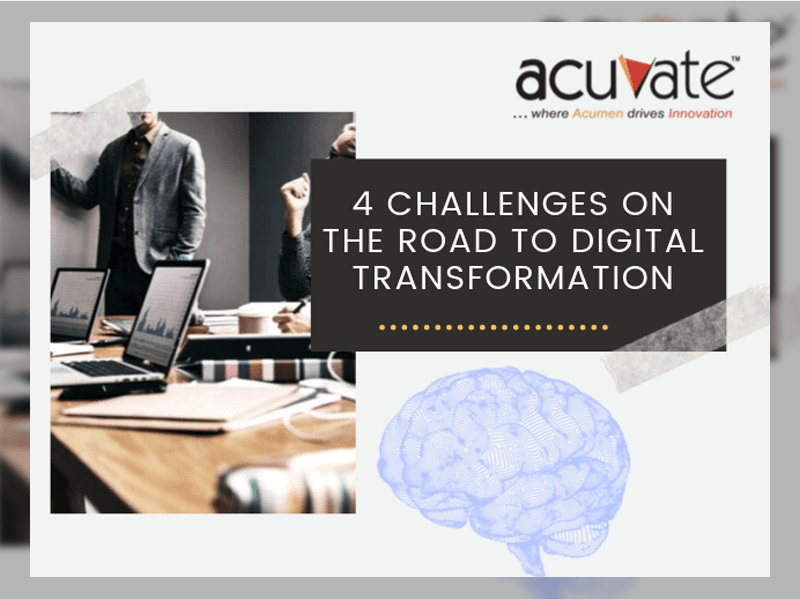Over a decade, tectonic changes in the technology ecosystem have transformed the way enterprises work. With the advancement in technologies, the need to embrace digital transformation is no longer optional.
How crucial is digital transformation to the modern business?
A global study from IDT found that 80% of businesses view digital transformation as a priority. Business leaders are clearly witnessing the need to adapt to the new digital reality. On the flip side, many organizations are not decked up to face the new reality of these changing technological landscape.
Digital transformation(DX) redefines your enterprise architecture and ensures to develop more sustainable solutions, right technological effectiveness.
The main purpose of digital transformation is to reinforce existing legacy systems by utilizing cutting edge technologies and cloud-based capabilities. It not only unlocks the next level of existing legacy applications and processes, but also helps discover new ways of working and value channels.
However, digital transformation is not as simple as we talk. While the majority are realizing the need, the strong roadblocks coming their way is dictating the success of the transformation efforts.
What’s holding them back? Let’s explore the major roadblocks that enterprises face in their digital transformation journey and how to overcome them.
4 Major Roadblocks to Digital Transformation Journey
1. Organizational Culture
According to Gartner’s research, organizational culture is the biggest blocker to digital transformation projects. Even if best of efforts are poured in planning, governing organisation-wide change can be a huge challenge.
If you fail to communicate the importance of digital transformation, employees might resist the change digital propose. Generally, employees are comfortable in their horizon and don’t wish to zone out to a different orbit until they realize the real impact easing their work life.
The huge organizational impact necessitates a deep-rooted strategy blending with the company’s core processes. Communicating regularly about the change and the benefits behind these changes deliver can keep your employees motivated eliminating resistance to change.
Modern intranets can come to your rescue! Communicating about the digital transformation duly using a modern intranet to counter the uncertainty from seeping in or eliminate all traces of anxiety keeping employees more informed and involved.
This helps in cultivating a culture of transparency and makes employees understand the reasoning why change is necessary to keep up with the changing landscape and how this change is going to benefit the business as well as them.
2. The Talent Gap
A report by CIO mentions a shortage of qualified, skilled IT talent as being the biggest roadblock to digital transformation. In an IDT study cited, only 17% of respondents had sufficient current employees with the right skills to see them through a smooth digital transformation.
DX entails a substantial set of modern skills, both in terms of technical, IT knowledge, and skills across other important functions. For many small and medium scale businesses, deep technology experts might not be available in-house.
Ensure to have all the best resources on your team to carry out successful transformation. Plan to upgrade employee skills to ensure they possess the required capabilities for the transformation.
Organizations have to decide whether to retrain internal staff or look for external help. Several vendors are also extending digital transformation roadmap definition and services around it for a quicker time to market and utilize the latest technology stack to get the job done effectively.
3. Legacy IT Systems
Sometimes the legacy system integration can be an influential barrier in the digital transformation. As most of the legacy IT infrastructure is set up in the context of the current implementations, enterprises remain under-equipped to inject the advanced technologies. Scalability of the infrastructure is a game-changer in the DX projects.
This occurs due to organizations following traditional processes with siloed application working without a common platform of connection. Otherwise, an existing legacy system might not be implemented with the right procedures to work with the latest technologies.
The initial and most prominent step to overcome this challenge is to invest in upgrading the scalable technology infrastructure. This will not only direct the current state of integrations but also assist prospective technological advancements.
So, before propelling new digital products or solutions into the organization, it is necessary to ensure your business architecture can withstand changing demands.
Read more about the topic in this article: 5 Tips For Legacy Modernization Through Integration
4. Technology – Business Alignment
According to PwC’s 6th Annual Digital IQ survey, only 54% of respondents agreed to a common business and IT corporate strategy, down from 60% last year.
IT is used to holding long-term vision on technology investments and for delivering solutions to the business. However, the ravenous demands of business units and technology implementations have formed bottlenecks for adoption. What’s needed is a flexible & iterative assemble-to-order approach to develop business services. The business and IT need to work consistently, collaboratively and incrementally.
A broad vision and robust planning are necessary measures when you consider digital transformation for your organization.
Conclusion
Considering the complexity of digital transformation, organizations need to build a substantial ecosystem to efficiently drive change. Outline a strategy that assures digital success by eliminating the roadblocks to DX. Also, a flexible strategy to adopt disruptive technologies without any hassle or delay forms the essential block.
Investing in technology alone might not equate to complete transformation success. People, process, technology forms the foundational elements while strategizing DX efforts. Making informed technology investments benefiting the larger spectrum deliver real value both to the organization and its customers.
It is a continuous process of improvement, development and innovation at regular intervals.
Still confused about digital adoption? Win your digital transformation journey by getting personalized tips from our specialists.



